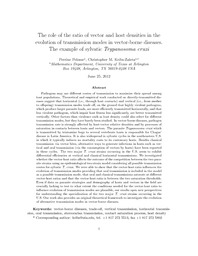| dc.contributor.author | Kribs, Christopher | |
| dc.contributor.author | Pelosse, Perrine | |
| dc.date.accessioned | 2016-05-11T19:41:23Z | |
| dc.date.available | 2016-05-11T19:41:23Z | |
| dc.date.issued | 2012 | |
| dc.identifier.citation | Published in the Journal of Theoretical Biology 312:133-142, November 2012 | en_US |
| dc.identifier.uri | http://hdl.handle.net/10106/25665 | |
| dc.description | Author's final draft after peer review, also known as a post print. | en_US |
| dc.description.abstract | Pathogens may use different routes of transmission to maximize their spread among
host populations. Theoretical and empirical work conducted on directly-transmitted diseases
suggest that horizontal (i.e., through host contacts) and vertical (i.e., from mother
to offspring) transmission modes trade off , on the ground that highly virulent pathogens,
which produce larger parasite loads, are more efficiently transmitted horizontally, and that
less virulent pathogens, which impair host fitness less significantly, are better transmitted
vertically. Other factors than virulence such as host density could also select for different
transmission modes, but they have barely been studied. In vector-borne diseases, pathogen
transmission rate is strongly affected by host-vector relative densities and by processes of
saturation in contacts between hosts and vectors. The parasite Trypanosoma cruzi which
is transmitted by triatomine bugs to several vertebrate hosts is responsible for Chagas'
disease in Latin America. It is also widespread in sylvatic cycles in the southeastern U.S.
in which it typically induces no mortality costs to its customary hosts. Besides classical
transmission via vector bites, alternative ways to generate infections in hosts such as vertical
and oral transmission (via the consumption of vectors by hosts) have been reported
in these cycles. The two major T. cruzi strains occurring in the U.S. seem to exhibit
differential effi ciencies at vertical and classical horizontal transmissions. We investigated
whether the vector-host ratio affects the outcome of the competition between the two parasite
strains using an epidemiological two-strain model considering all possible transmission
routes for sylvatic T. cruzi. We were able to show that the vector-host ratio influences the evolution of transmission modes providing that oral transmission is included in the model
as a possible transmission mode, that oral and classical transmissions saturate at different
vector-host ratios and that the vector-host ratio is between the two saturation thresholds.
Even if data on parasite strategies and demography of hosts and vectors in the field are
crucially lacking to test to what extent the conditions needed for the vector-host ratio to
influence evolution of transmission modes are plausible, our results open new perspectives
for understanding the specialization of the two major T. cruzi strains occurring in the
U.S. Our work also provides an original theoretical framework to investigate the evolution
of alternative transmission modes in vector-borne diseases. | en_US |
| dc.description.sponsorship | This research was supported by the National Science Foundation under
Grant DMS-1020880. | |
| dc.language.iso | en_US | en_US |
| dc.subject | Vector-borne diseases | en_US |
| dc.subject | Trade-off | en_US |
| dc.subject | Vertical transmission | en_US |
| dc.subject | Horizontal transmission | en_US |
| dc.subject | Oral transmission | en_US |
| dc.subject | Stercorarian transmission | en_US |
| dc.subject | Contact saturation porcess | en_US |
| dc.subject | Host density | en_US |
| dc.title | The role of the ratio of vector and host densities in the evolution of transmission modes in vector-borne diseases. The example of sylvatic Trypanosoma cruzi | en_US |
| dc.type | Article | en_US |
| dc.publisher.department | Department of Mathematics, University of Texas at Arlington | |
| dc.identifier.externalLinkDescription | The original publication is available at Article DOI. | |
| dc.identifier.doi | http://dx.doi:10.1016/j.jtbi.2012.07.028 | |

